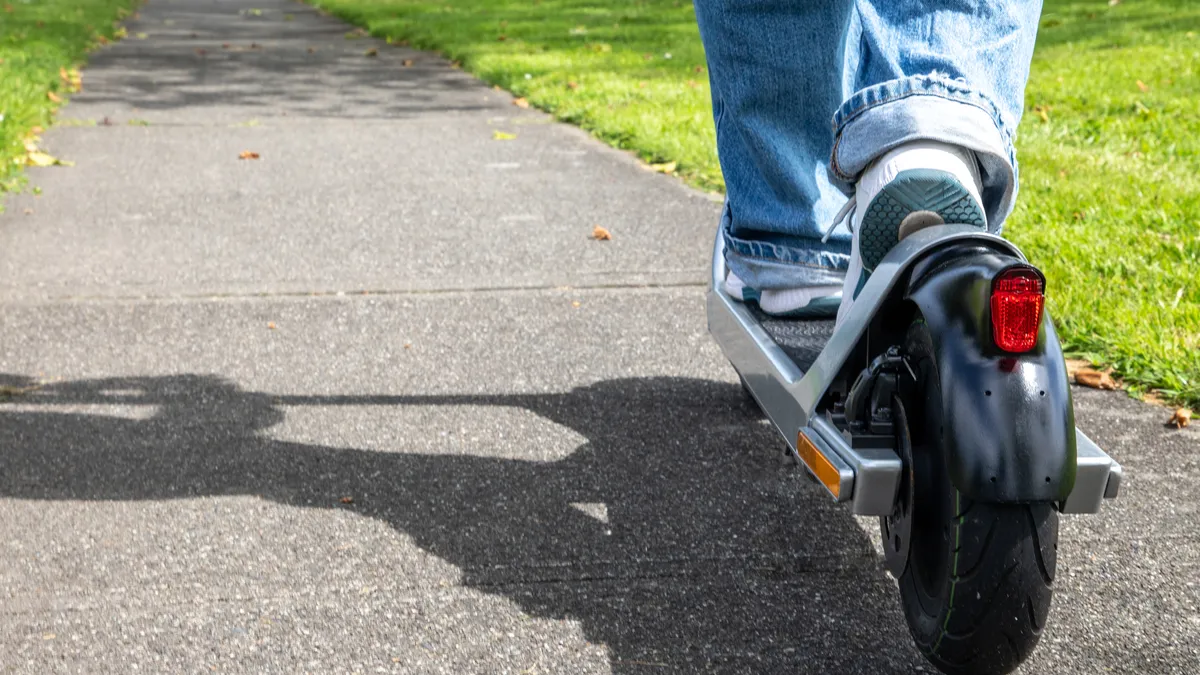Dive Brief:
-
Mandating low travel speeds for shared electric scooters may lead more people to ride them on sidewalks, putting riders in less danger from cars but increasing the risk of a crash with a pedestrian, according to an Insurance Institute for Highway Safety study published Tuesday.
-
E-scooter riders overwhelmingly used available bike lanes in the cities compared in the study: Austin, Texas, which limits e-scooter speeds to 20 mph, and Washington, D.C., which caps speeds at 10 mph. Where there were no bike lanes, D.C. riders were 44% more likely to ride on the sidewalk than Austin riders, the study found.
-
The clear preference for bike lanes “gives communities another reason to focus on expanding their bicycle networks,” Jessica Cicchino, IIHS vice president of research and the study’s lead author, said in a statement. She also said, “slowing down the fastest sidewalk riders should help prevent crashes and reduce the severity of injuries when e-scooters hit pedestrians.”
Dive Insight:
Local officials increasingly view shared micromobility as a way to potentially reduce climate pollution, ease traffic congestion and improve transportation equity. But growing safety concerns have led to e-scooter bans and other restrictions that can leave some riders behind by cutting off access to a more affordable mode of transportation.
In a 2022 report, the U.S. Consumer Product Safety Commission estimated that e-scooter injuries led to nearly 118,000 emergency department visits from 2017 through 2021, increasing from 7,700 in 2017 to 42,200 in 2021. Dockless and/or rental e-scooters accounted for 28% of those visits but may be underestimated because not all such e-scooters may be properly identified in the data, the report says.
A 2020 IIHS study found that nearly 3 in 5 e-scooter riders were injured while riding on a sidewalk compared to about 1 in 5 riding in a bike lane, trail or other off-road location. Injuries are more severe when e-scooter users are riding in motor vehicle travel lanes rather than sidewalks, bike lanes or multiuse trails, the 2020 study found.
The IIHS study published Tuesday found that in both Austin and D.C., e-scooter speeds were lower on sidewalks than on roads or bike lanes. “E-scooter users clearly take risk into account when choosing where to ride,” Cicchino said. “Many are also conscious of the risk of hitting a pedestrian.”
However, Austin riders were more likely to ride faster on sidewalks, with 2 in 5 riders driving more than 10 mph on sidewalks. In D.C., on the other hand, less than 1 in 5 e-scooter riders drove more than 10 mph on sidewalks.
“A substantial portion of Austin riders sped along at 15 mph or more on the sidewalk as well,” the study says.
The researchers also found that two-thirds of e-scooter users in Washington’s central business district rode on sidewalks when there were no bike lanes, even though sidewalk riding is banned.
“There’s little evidence sidewalk bans are any more effective elsewhere,” the study says. “Nevertheless, two-thirds of U.S. communities are considering them or have them in place already.”
Shared micromobility operators Bird, Lime, Spin and Superpedestrian last week recommended that local governments limit shared e-bike and e-scooter speeds to 15 mph.
"We joined our industry partners in putting forward a recommended 15mph speed limit to balance cities' tendency to be apprehensive about higher speeds, with the need for a fast enough ride to encourage modal shift from cars,” a Lime spokesperson said in an email. “That said, we agree with IIHS' findings that lower speeds can be a contributor to sidewalk riding.”
However, the spokesperson said, “the lack of safe riding infrastructure on city streets” is a greater issue.
Yu Zhang, a civil and environmental engineering professor at the University of South Florida, agreed, saying in an interview that there are often larger speed differences between e-scooters and pedestrians than between e-scooters and cars, which can raise the likelihood of a crash.
The Lime spokesperson added that “if cities are serious about reducing or eliminating sidewalk riding, they will reduce the speed of cars on local streets and invest in infrastructure like protected bike lanes, which are proven to make streets safer for all users.”
Bird, Lime, Spin and Superpedestrian did not address motor vehicle speeds or infrastructure, except parking requirements, in their recommendations.











